-
-
FeaturesคุณสมบัติPenyelesaianRecursosFiturCaracterísticas精选功能功能特點المزايا
-
Solutionsโซลูชั่นPenyelesaianSoluçõesSolusiSoluciones解决方案解決方案الحلول
-
IntegrationsการผสานรวมIntegrasiIntegraçõesIntegrationsIntegraciones集成整合服務دمج مع تطبيقات أخرى
-
Affiliate/Partnersพันธมิตร/พันธมิตรทรัพยากรAfiliasi/Rakan KongsiAfiliados/ParceirosAfiliasi/MitraAfiliados/Partners联盟/合作伙伴聯盟/合作夥伴شريك
-
ResourcesจองการสาธิตSumberRecursosSumber dayaRecursosالموارد資源中心
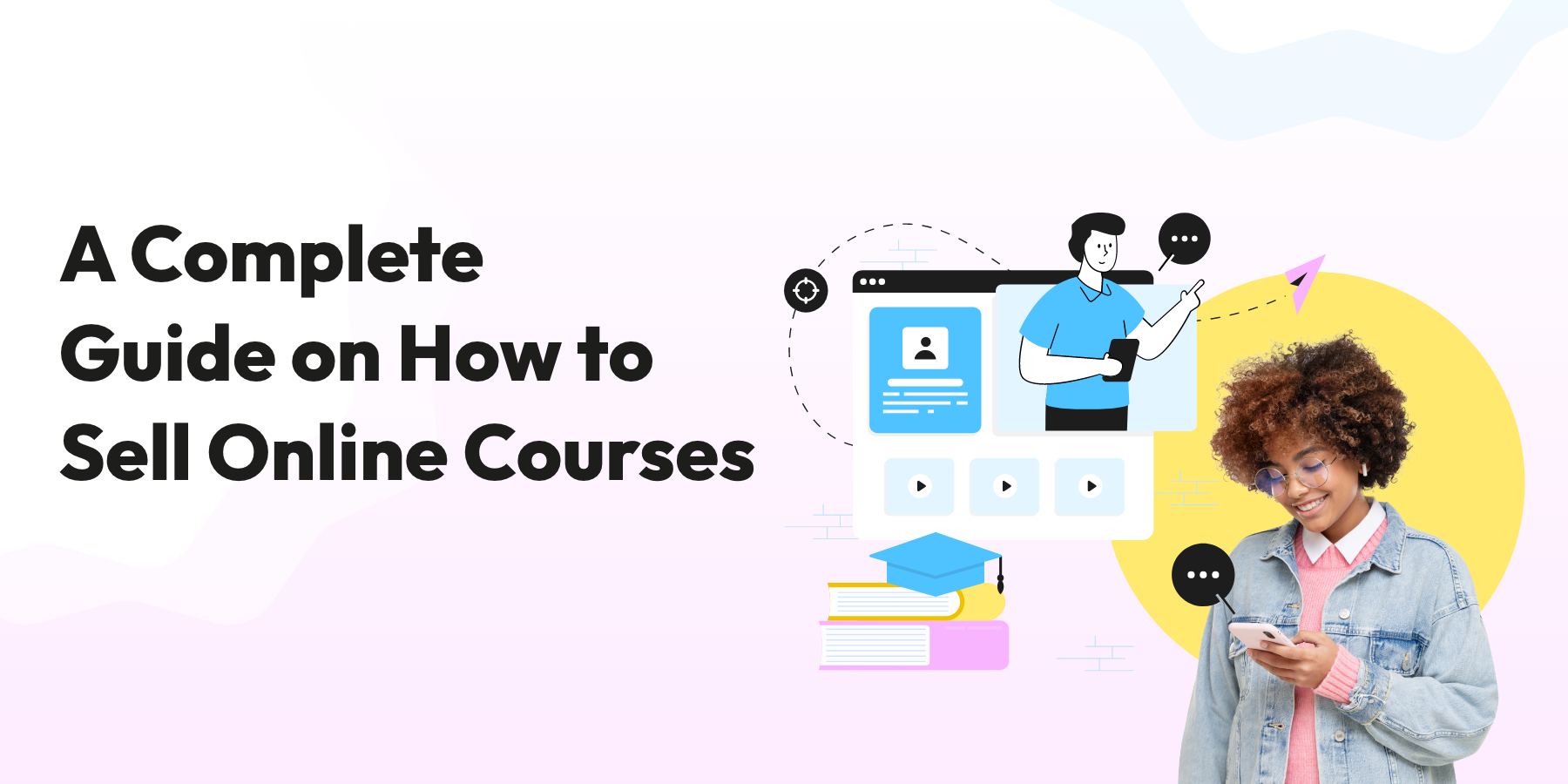
A Complete Guide on How to Sell Online Courses in 2025
You’ve got valuable knowledge, a passionate audience, and a burning desire to share your expertise. But transforming that knowledge into a successful online course feels overwhelming. Where do you start? How do you stand out in a sea of content? If you’re an educator, influencer, or expert grappling with these questions, you’re not alone.
This comprehensive guide is your roadmap to creating, marketing, and selling online courses that resonate with your audience and generate real income. From pinpointing the perfect course topic to launching with impact, we’ll walk you through each step of the process. Get ready to unlock the potential of your knowledge and join the thriving world of e-learning entrepreneurship.
Choosing Your Course Topic
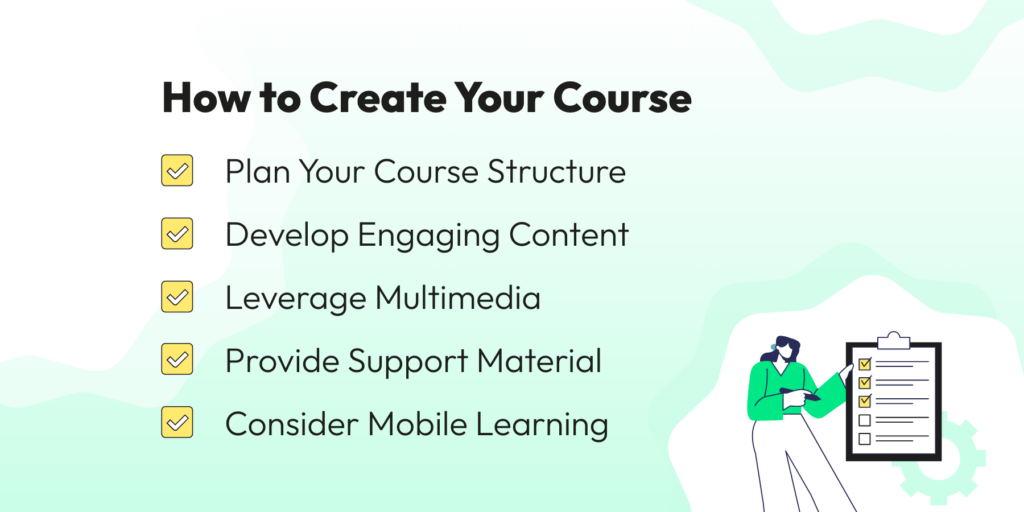
1. Identify Your Expertise
When venturing into the world of selling online courses, start by reflecting on your areas of expertise. For this, you can start by asking questions like:
- What skills have you honed over the years?
- What knowledge do you possess that others find valuable?
- What are your unique experiences and insights that can form the foundation of a compelling course?
To help you answer these questions, take a moment to brainstorm. List 5-10 topics you’re passionate about or skilled in. Don’t censor yourself – include everything from professional skills to personal hobbies. This exercise can reveal patterns and highlight areas where your expertise and passion intersect.
I know there would be multiple answers to the above questions. But by answering all the above questions, you can try to connect the dots and find a common answer that hits the bull’s eye.
2. Assess Market Demand
While passion is crucial, it’s equally important to ensure there’s a market to sell online courses.
Here’s how to gauge demand:
1. Keyword Research: Use tools like Google Keyword Planner, Google Trends, AHREFS, and SEMRUSH to explore search volumes for topics related to your expertise.
2. Social Media Listening: Monitor social platforms to identify trending topics and common pain points in your niche.
3. Competitor Analysis: Research existing courses in your field. Look for gaps you can fill or areas where you can offer a unique perspective.
3. Consider Your Target Audience
Understanding your potential students is key to sell online courses. To research your target audience, you can study the following things.
Demographics: Your audience likely includes students and young professionals looking to upskill. Or this could change depending on your online course.
Pain Points: Determine the specific challenges or problems your audience faces in their personal or professional lives that your online course could address.
Skill Gaps: Analyze the current market demands and identify the skills your target audience needs to acquire or improve to advance in their careers or personal development.
Learning Goals: Consider what your audience aims to achieve by taking your course. Are they looking for certification, practical skills, theoretical knowledge, or a combination of these?
Competition Research: Study existing courses or resources in your field to understand what’s already available and how you can differentiate your offering.
4. Test Your Idea
Before fully committing to course development:
1. Create a Mini-Course: Offer a free webinar or short course to gauge interest and gather feedback.
2. Survey Your Audience: Use social media or email to ask potential students what they’d like to learn.
3. Engage in Online Communities: Participate in forums or social groups related to your topic to understand common questions and challenges.
5. Align with Business Goals
If you’re part of a larger organization or academy:
- Ensure your course topic aligns with your overall brand and offerings
- Consider how the course can lead students to other products or services you offer
- Think about scalability – can this course be easily updated or expanded in the future?
By carefully selecting your course topic, you’re laying the groundwork for success in the competitive e-learning market. Remember, the key is to find the sweet spot where your expertise meets market demand and your audience’s needs.
Creating Your Course
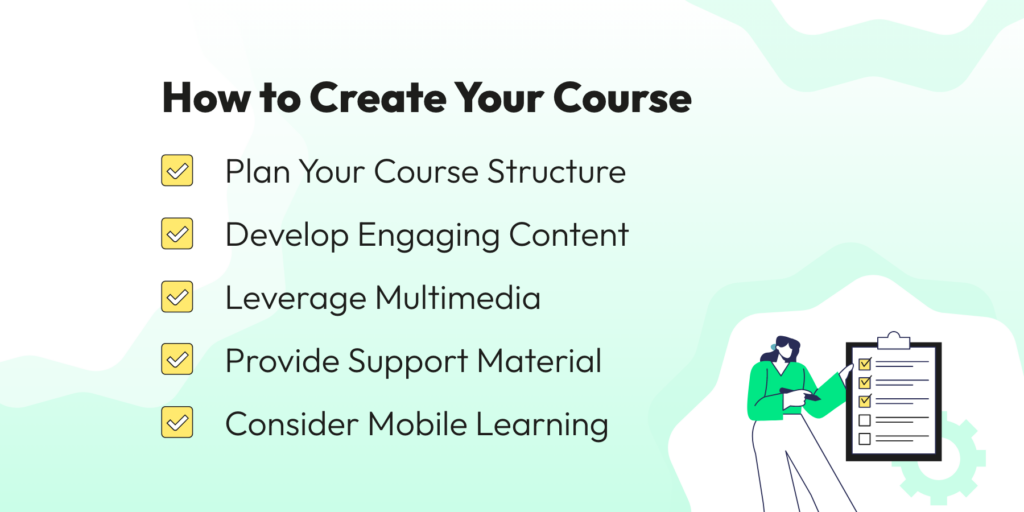
1. Plan Your Course Structure
Before diving into content creation, map out your course structure:
- Define Learning Objectives: Clearly state what students will be able to do after completing your course.
- Outline Modules: Break your course into logical sections or modules.
- Plan Individual Lessons: Within each module, outline specific lessons or topics to cover.
Remember, a well-structured course helps students stay engaged and motivated throughout their learning journey.
2. Develop Engaging Content
With your structure in place, focus on creating compelling content:
- Vary Content Types: Mix video lectures, text-based lessons, quizzes, and practical exercises to cater to different learning styles.
- Keep It Concise: Aim for bite-sized lessons that are easy to digest. For video content, try to keep each lesson under 10 minutes.
- Use Real-World Examples: Incorporate case studies and practical applications to make your content more relatable and valuable.
You can checkout our Wati Academy course where we have tried to keep the course engaging by including bite-sized content, video lectures, quizzes, etc.
3. Leverage Multimedia
Given the popularity of platforms like YouTube and Instagram among your target audience, ensure that your course has:
- High-Quality Video: Invest in good lighting and audio equipment for professional-looking video lessons.
- Visual Aids: Use infographics, charts, and animations to explain complex concepts.
- Screen Recordings: For technical topics, include screen captures to demonstrate processes step-by-step.
4. Provide Support Materials
Enhance the learning experience with additional resources:
- Downloadable Resources: Offer cheat sheets, templates, or workbooks that students can use alongside your lessons.
- Supplementary Reading: Curate a list of articles, books, or research papers for students who want to dive deeper.
- Glossary: For courses with specialized terminology, provide a glossary of key terms.
5. Consider Mobile Learning
With many learners accessing courses on-the-go:
- Ensure your course platform is mobile-responsive
- Design content that’s easily consumed on smaller screens
- Consider creating a companion mobile app for your course
Building Your Sales Landing Page
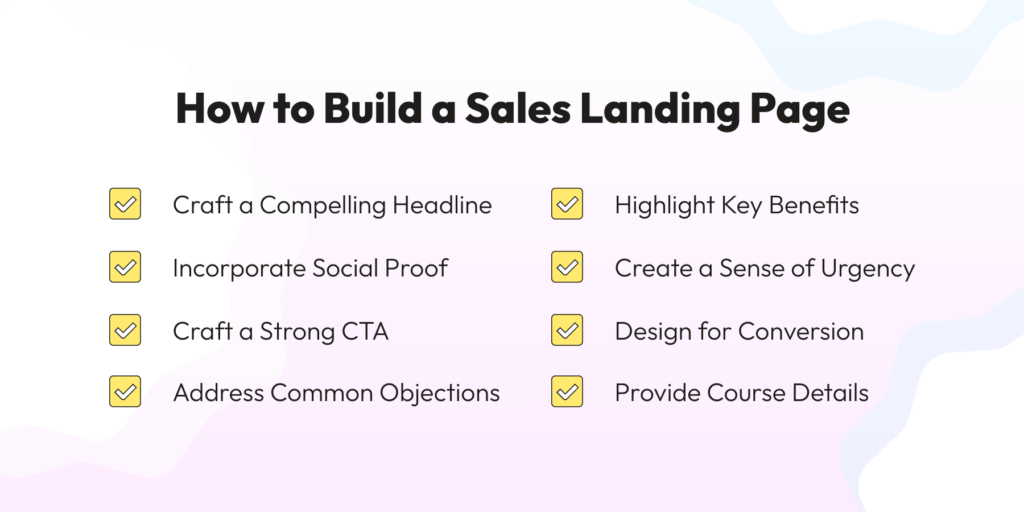
1. Craft a Compelling Headline
Your headline is the first thing visitors see:
- Make it clear, concise, and benefit-driven
- Use power words that resonate with your audience
- Consider A/B testing different headlines to see which performs best
Example: “Master Digital Marketing in 8 Weeks: Boost Your Career and Drive Growth”
2. Highlight Key Benefits
Clearly communicate the value of your course:
- Use Bullet Points: List the top 3-5 benefits of your course
- Be Specific: Instead of vague promises, offer concrete outcomes
- Address Pain Points: Show how your course solves specific problems
Example:
- Learn cutting-edge strategies used by top 1% of marketers
- Gain hands-on experience with real-world projects
3. Incorporate Social Proof
Build trust with potential students:
- Testimonials: Feature quotes from satisfied students, preferably with their job titles and company names
- Success Stories: Showcase before-and-after scenarios of previous students
- Logos: If applicable, display logos of companies where your students work
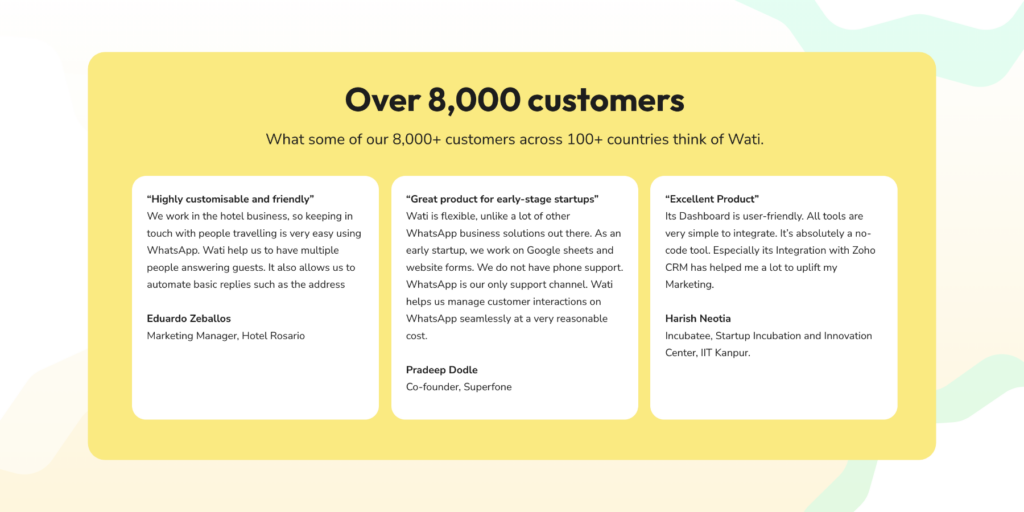
4. Create a Sense of Urgency
Encourage immediate action:
- Offer limited-time discounts
- Highlight limited spots available for the next cohort
- Use countdown timers for enrollment deadlines
5. Design for Conversion
Optimize your page layout:
- Clean, Professional Design: Use a layout that’s easy to navigate and aligns with your brand
- Mobile Responsiveness: Ensure your page looks great on all devices
- Strategic Use of White Space: Make your content easy to scan and digest
- Compelling Visuals: Include high-quality images or videos of your course in action
6. Craft a Strong Call-to-Action (CTA)
Your CTA should be impossible to miss:
- Use contrasting colors to make your CTA button stand out
- Write action-oriented button text (e.g., “Enroll Now” or “Secure Your Spot”)
- Place CTAs strategically throughout the page, especially above the fold
7. Provide Course Details
Give potential students a clear picture of what to expect:
- Course Outline: Briefly list the modules or topics covered
- Duration and Format: Specify the length of the course and how it’s delivered (e.g., “8 weeks, 2 live sessions per week”)
- Instructor Bio: Highlight your expertise and credentials
8. Address Common Objections
Anticipate and overcome potential hesitations:
- Money-Back Guarantee: Offer a risk-free trial period
- Flexible Payment Options: Consider installment plans
- Support Details: Explain what kind of support students can expect
9. Leverage WhatsApp Integration
a. WhatsApp Button
Add a prominent WhatsApp chat button to your website, landing pages, and email communications. This button should be easily visible and strategically placed, such as next to course descriptions or in the contact section.
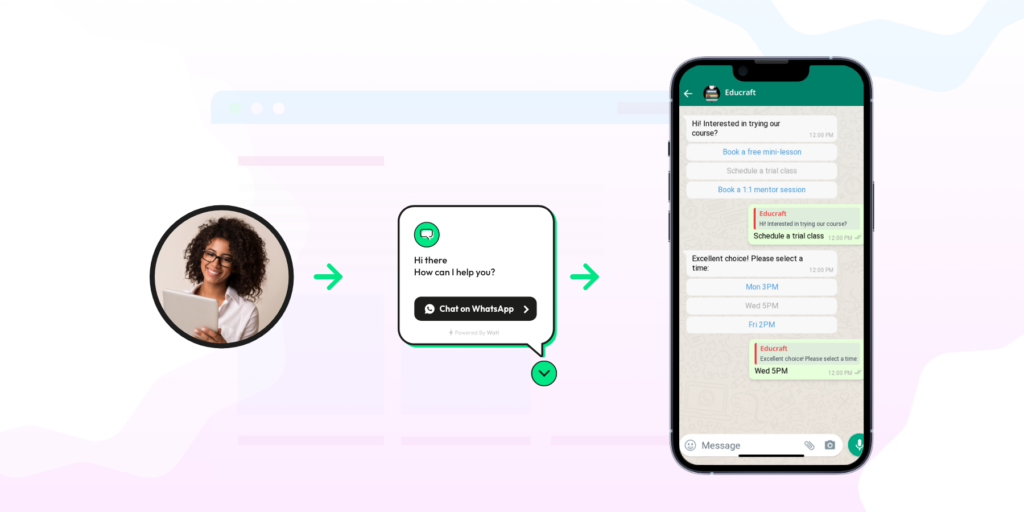
When clicked, it opens a direct WhatsApp chat with your business, allowing potential students to instantly inquire about courses, pricing, or any other questions they might have. This immediate access to support can significantly reduce friction in the decision-making process and increase conversion rates.
Also Read: How to add WhatsApp Chat Button to the Website? (2025)
2. QR Code:
Include a WhatsApp QR code in your offline marketing materials, such as brochures, posters, or business cards. This QR code, when scanned with a smartphone camera, automatically opens a WhatsApp chat with your business.

It’s particularly effective for bridging the gap between physical and digital marketing efforts. For instance, if you’re presenting at an education fair or hosting a local workshop, attendees can quickly scan the QR code to continue the conversation on WhatsApp, ensuring you don’t lose potential leads once the event is over.
Related Read: A Comprehensive Guide to Using WhatsApp Web QR Code: Step-by-Step Tutorial
10. Optimize for Search Engines
Improve your page’s visibility:
- Use relevant keywords naturally throughout your content
- Optimize meta titles and descriptions
- Ensure fast loading times for better user experience and SEO
By focusing on these elements, you’ll create a high-converting sales landing page that speaks directly to your target audience in the e-learning industry. Remember, your landing page is often the first impression potential students have of your course, so make it count!
Pricing Your Course
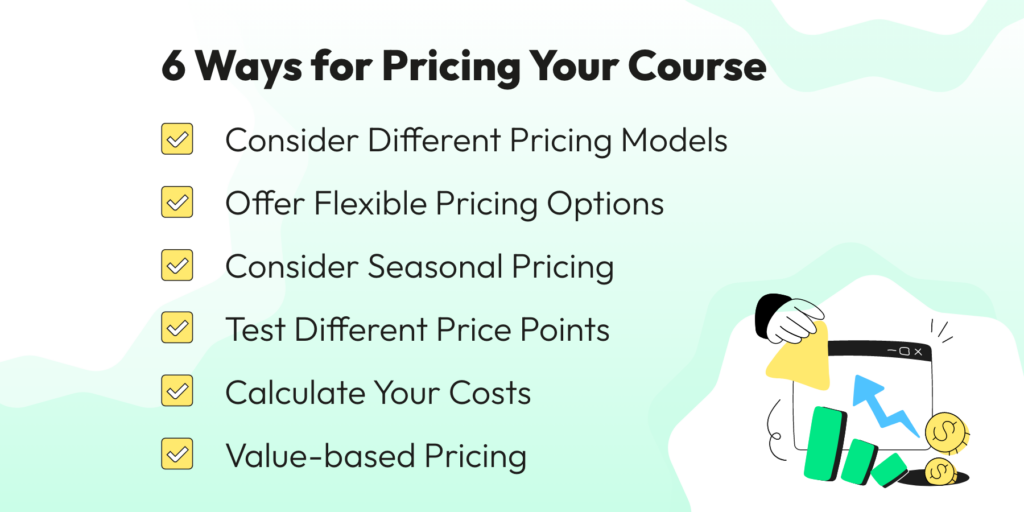
1. Calculate Your Costs
Factor in all expenses associated with creating and running your course:
- Content Creation: Time spent developing materials, recording videos, etc.
- Platform Fees: Costs for hosting your course on an e-learning platform
- Marketing Expenses: Budget for ads, promotions, and sales efforts
- Support Costs: Time or resources dedicated to student support
- Tools and Software: Any subscriptions or tools needed to deliver the course
2. Consider Different Pricing Models
Explore various pricing strategies to find what works best:
- One-Time Fee: A single payment for lifetime access
- Subscription Model: Monthly or annual payments for ongoing access
- Tiered Pricing: Offer different levels (e.g., Basic, Premium, VIP) with varying features
- Pay-Per-Module: Allow students to purchase individual modules separately
3. Value-Based Pricing
Focus on the value your course provides:
- Career Advancement: If your course leads to promotions or salary increases, price it accordingly
- Skill Development: Highlight the market value of the skills taught
- Time Savings: Emphasize how your course fast-tracks learning compared to self-study
4. Offer Flexible Payment Options
Make your course more accessible:
- Installment Plans: Allow students to spread the cost over several months
- Early Bird Discounts: Reward early sign-ups with special pricing
- Group Discounts: Offer reduced rates for companies enrolling multiple employees
5. Test Different Price Points
Don’t be afraid to experiment:
- A/B Testing: Try different prices and analyze conversion rates
- Surveys: Ask your target audience what they’d be willing to pay
- Limited-Time Offers: Use promotional periods to test price sensitivity
6. Consider Seasonal Pricing
Adjust your pricing strategy based on demand:
- Offer special rates during peak enrollment seasons (e.g., New Year, fiscal year-end)
- Create “back to school” promotions aligned with traditional academic calendars
Marketing Your Course
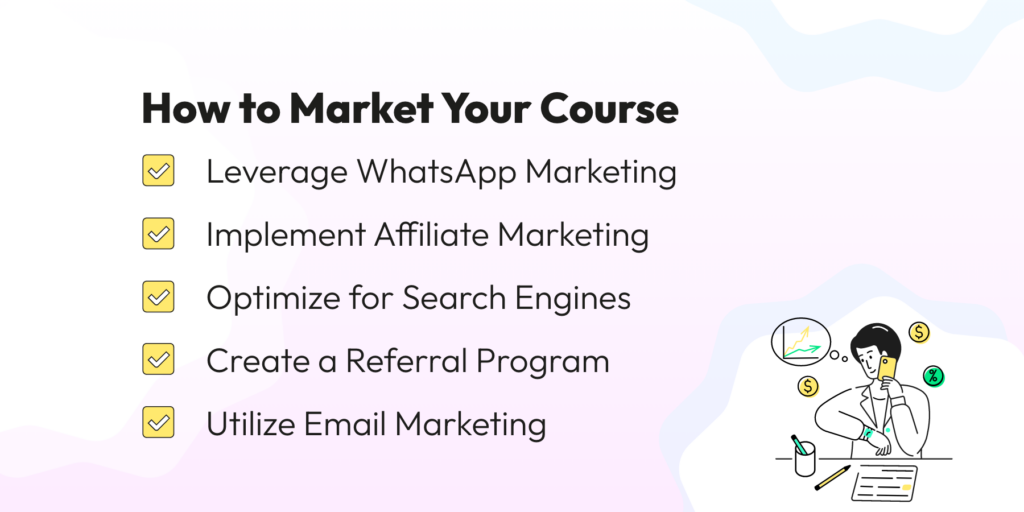
1. Leverage WhatsApp Marketing to Market Your Online Course
WhatsApp has become an essential tool for eLearning businesses looking to boost their marketing efforts. With WhatsApp, you get unique advantages like:
- Direct access to your audience: With over 2.8 billion users worldwide, WhatsApp provides an unparalleled reach.
- High engagement rates: Messages on WhatsApp have an open rate of up to 98%, far surpassing email marketing.
- Personal touch: The conversational nature of WhatsApp allows for more personalized interactions with potential students.
Now, let’s have a look at how different elearning marketing strategies that you can implement using WhatsApp.
a. Automate Webinar Reminders
Free webinars are a crucial lead generation tool for eLearning businesses. They offer potential students a taste of your teaching style and content quality. However, with the increasing number of online offerings, ensuring registrants actually attend can be challenging. This is where WhatsApp automation can make a significant difference.
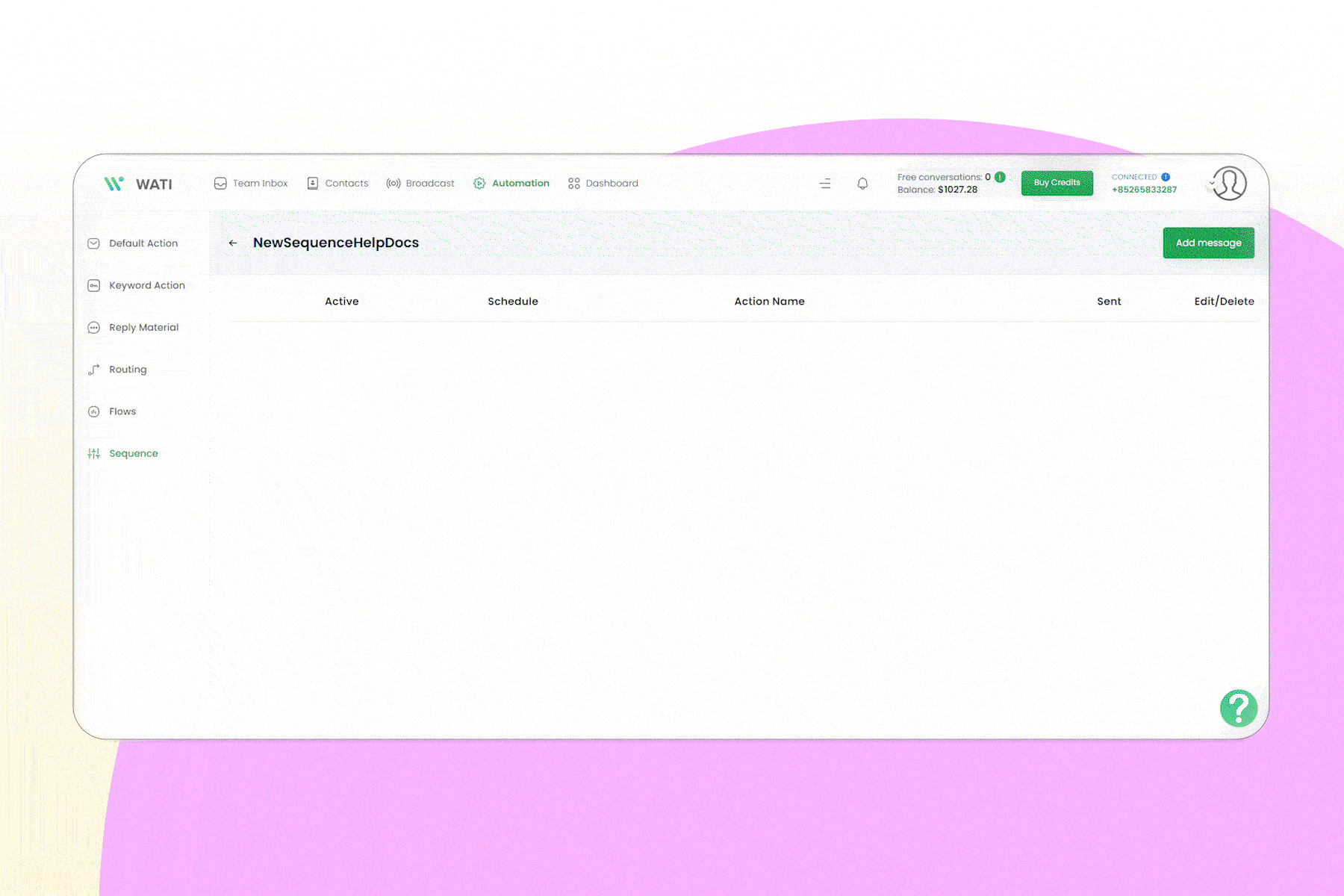
To increase webinar attendance and engagement, you can leverage WhatsApp reminders in the following ways:
- Send automated reminders before webinars:
- 48 hours before: Remind participants about the upcoming webinar, its topic, and key takeaways.
- 24 hours before: Send a friendly reminder with the webinar agenda and any preparation needed.
- 2 hours before: Dispatch a “Get ready!” message with the joining link and technical requirements.
- 15 minutes before: Send a final reminder to log in and get settled.
- Optimize reminder timing:
- Analyze attendance data to identify the most effective reminder schedule for your audience.
- Adjust the frequency and timing of reminders based on these insights.
By implementing these targeted WhatsApp reminder strategies, you can significantly increase webinar attendance rates, ensuring more potential students experience your valuable content firsthand. This enhanced engagement can lead to higher conversion rates for your paid online courses.
Also Read: Top 5 Marketing Strategies to Increase Student Enrollment for Online Courses
b. Post-Webinar Lead Nurturing with WhatsApp
After hosting a successful webinar, use WhatsApp to nurture your leads effectively. Here’s a streamlined 4-message sequence to keep your audience engaged and guide them towards your paid courses. You can increase or decrease the number of messages in your sequence as per your requirement.
1. Immediate Follow-Up (Within 1 hour post-webinar):
- Thank attendees for their participation
- Provide the webinar replay link for both attendees and no-shows
- Include a brief, one-question survey about their experience
- Remind them of any special offer mentioned during the webinar
2. Value-Add Content (Day 2 post-webinar):
- Share a downloadable resource that expands on a key webinar topic
- Invite recipients to ask questions about the content
- Briefly mention how your full course delves deeper into this subject
3. Course Introduction (Day 5 post-webinar):
- Introduce your related paid course
- Highlight how it builds on the webinar content
- Share a student success story or testimonial
- Offer a limited-time discount for webinar attendees
4. Final Reminder (Day 7 post-webinar):
- Send a last-call message about the special offer ending soon
- Reiterate 2-3 key benefits of your course
- Provide a clear call-to-action to enroll
- Invite them to reply with any final questions
Also Read: How to Increase Registration & Engagement for Elearning Webinars With WhatsApp Marketing
This concise WhatsApp nurture sequence maintains engagement with your webinar leads while guiding them towards your paid course offerings. By providing value and creating urgency, you can effectively convert more webinar attendees into students. Remember to always include an easy opt-out option in each message to comply with messaging regulations.
c. Leverage WhatsApp Broadcasts for eLearning Businesses
WhatsApp broadcasts offer a powerful way to reach your audience directly. Here are seven key scenarios where you can use them effectively:
1. Limited-Time Offers
- Send time-sensitive discounts on popular courses
- Announce flash sales for specific programs
- Create urgency with countdown timers for offer expiration
2. New Course Launches
- Introduce new courses or programs to your audience
- Offer early-bird discounts for quick sign-ups
- Share sneak peeks or teasers of course content
3. Enrollment Deadlines
- Remind leads about closing registration dates
- Send last-chance notifications for upcoming batches
- Highlight limited spots available for exclusive programs
4. Free Resource Alerts
- Announce new free webinars or workshops
- Share downloadable study materials or cheat sheets
- Offer limited-time access to premium content
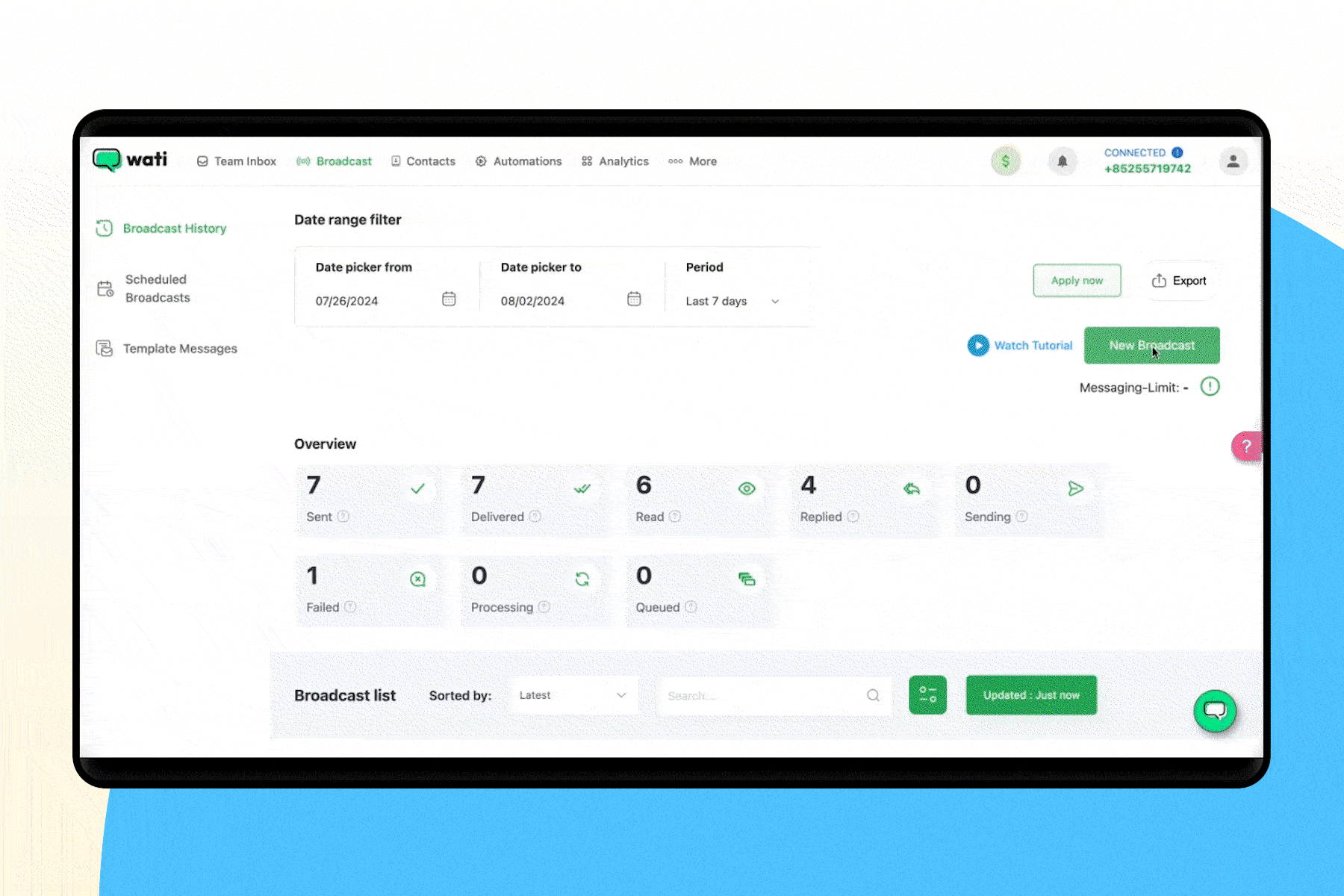
5. Student Success Stories
- Broadcast testimonials from successful students
- Share before-and-after scenarios of learners
- Highlight job placements or career advancements of alumni
6. Personalized Milestone Reminders
- Celebrate learning milestones of individual students
- Encourage those who’ve been inactive to resume their studies
- Offer special “comeback” deals for learners who’ve paused their courses
7. Community Events
- Announce upcoming Q&A sessions with instructors
- Invite students to networking events or meetups
- Promote hackathons or competitions related to your courses
Also Read: How to Create a WhatsApp Broadcast List: A Quick Guide (2025)
By strategically using these broadcast messages, you can keep your audience engaged, create a sense of community, and drive conversions for your eLearning business. Remember to segment your audience and tailor your messages to ensure relevance and maintain high engagement rates.
d. Implement Lead Qualification Chatbots
WhatsApp chatbots can streamline your lead qualification process while providing a personalized experience for potential students. Here are five key chat flows an eLearning business can create:
1. Limited-Time Offer and Urgency Flow
- Promote time-sensitive discounts on courses
- Highlight upcoming batch start dates
- Create urgency with countdown timers for offer expiration
- Provide quick enrollment options within the chat
2. Course Finder and Information Flow
- Ask about learning goals and current skill level
- Recommend suitable courses based on responses
- Provide quick course overviews with pricing information
- Offer option to speak with a sales representative for more details
3. Lead Scoring and Qualification Flow
- Ask targeted questions to determine lead quality
- Inquire about budget and timeline for starting the course
- Assign scores based on responses
- Route high-scoring leads to sales representatives for immediate follow-up
4. Free Trial or Demo Lesson Flow
- Offer a snippet of course content or a free mini-course
- Schedule a free trial class or 1:1 session with a mentor
- Send reminders and follow-up after the trial to encourage enrollment
5. Student Support and Engagement Flow
- Provide quick access to FAQs about course logistics
- Offer technical support for accessing online materials
- Connect students with their assigned mentors (for 1:1 programs)
- Gather feedback and address concerns promptly
By implementing these targeted WhatsApp chat flows, you’re not just automating conversations – you’re creating a responsive ecosystem that nurtures leads and supports students at every stage. Remember, the real power lies in personalization and timing. Use the data gathered from these interactions to continually refine your approach. Pay attention to which flows generate the most engagement and conversions, then adjust accordingly.
Don’t be afraid to experiment with message timing, tone, and content to find what resonates best with your audience. With WhatsApp’s high open rates and personal touch, you have a unique opportunity to stand out in the crowded eLearning market. Embrace these chatbot strategies, and you’ll not only streamline your marketing efforts but also build stronger, more meaningful connections with your students.
Also Read: WhatsApp for Education: Empowering Learning in the Digital Era
e. Retarget Your Audience with Click-to-WhatsApp Ads
As an eLearning business, you’re constantly looking for ways to re-engage potential students who’ve shown interest but haven’t yet committed. Click-to-WhatsApp (CTWA) ads offer a powerful retargeting solution that combines the precision of social media advertising with the personal touch of WhatsApp conversations.
Why CTWA Ads Excel at Retargeting
- Direct Communication: Unlike traditional retargeting ads that lead to a landing page, CTWA ads open a WhatsApp chat, allowing for immediate, personal interaction.
- Higher Engagement: People are more likely to respond to a WhatsApp message than a typical ad, increasing your chances of conversion.
- Personalized Follow-ups: Use the information you’ve gathered about a lead to create tailored retargeting messages.
- Overcome Objections in Real-Time: Address any concerns or questions that might have prevented the initial sign-up.
Retargeting Strategies for eLearning Businesses
- Course Abandoners
- Target users who visited your course page but didn’t enroll
- Ad Copy: “Still interested in [Course Name]? Let’s chat about your goals!”
- Webinar No-Shows
- Reach out to those who registered for a webinar but didn’t attend
- Ad Copy: “Missed our webinar? Get a personalized recap via WhatsApp!”
- Free Trial Users
- Retarget those who took a free trial but didn’t upgrade
- Ad Copy: “Enjoyed your free lesson? Let’s discuss your full learning journey!”
- Cart Abandoners
- Re-engage users who added a course to their cart but didn’t complete the purchase
- Ad Copy: “Your course is waiting! Chat with us for a special offer.”
- Partial Video Viewers
- Target YouTube or Facebook users who watched part of your course previews
- Ad Copy: “Curious about the full course? Ask us anything via WhatsApp!”
- Inactive Students
- Reach out to enrolled students who haven’t logged in recently
- Ad Copy: “Ready to continue your learning? Let’s get you back on track!”
- Cross-Selling Opportunities
- Target students who completed one course to suggest complementary ones
- Ad Copy: “Ready for your next challenge? Chat about our advanced courses!”
How can Wati Help
Setting up a CTWA Ad on Wati is quick and easy. To know more about how you can set up a CTWA Ad, watch this video 👇
That’s not it, we have an entire CTWA playlist on YouTube that helps you know
- CTWA advantages
- CTWA best practices
- Measuring & optimizing CTWA
By implementing these CTWA retargeting strategies, you can turn missed opportunities into successful conversions, providing a personal touch that sets your eLearning business apart in a crowded digital landscape.
Also Read: Everything You Need to Know About WhatsApp Elearning
2. Optimize for Search Engines (SEO)
Improve your course’s visibility online:
- Conduct keyword research relevant to your course topic
- Optimize your course landing page with targeted keywords
- Create high-quality, SEO-friendly content related to your course
- Build backlinks through guest posting and partnerships
3. Utilize Email Marketing Effectively
Design strategic email campaigns:
- Welcome Series: Introduce new subscribers to your course offerings
- Nurture Sequence: Provide value and build trust over time
- Promotional Emails: Highlight special offers and course benefits
- Re-engagement Campaigns: Reach out to inactive subscribers
4. Create a Referral Program
Encourage word-of-mouth marketing:
- Offer incentives for current students who refer new enrollees
- Provide easy-to-share content and referral links
- Consider a tiered referral system with increasing rewards
5. Utilize Video Marketing
Engage your audience visually:
- Course Trailers: Create compelling video previews of your course
- Student Success Stories: Film short testimonials from successful students
- Behind-the-Scenes Content: Show the course creation process to build anticipation
- Live Q&A Sessions: Host regular live streams to answer questions about your course
6. Implement Affiliate Marketing
Expand your reach through partnerships:
- Partner with industry influencers and thought leaders
- Offer competitive commission rates for successful referrals
- Provide affiliates with marketing materials and tracking tools

Remember, effective course marketing is an ongoing process. Continuously test, analyze, and refine your strategies to stay ahead in the competitive e-learning market. By focusing on these diverse marketing tactics and tailoring them to your professional audience, you’ll be well-positioned to attract and retain students for your online courses.
Launching Your Course
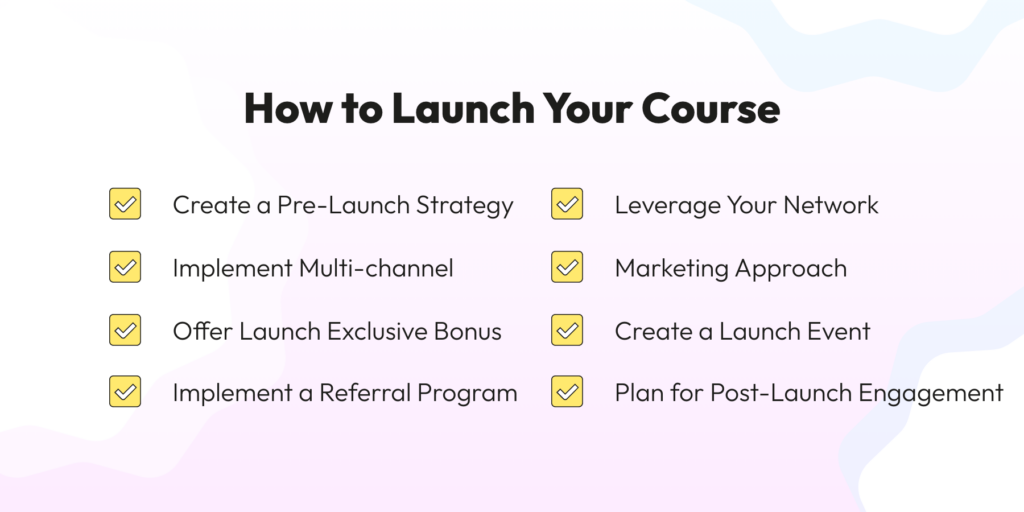
1. Create a Pre-Launch Strategy
Build anticipation before your official launch:
- Email Teasers: Send a series of emails highlighting course benefits
- Social Media Countdown: Use platforms like Instagram and LinkedIn to create buzz
- Early Bird Offers: Provide special pricing or bonuses for early sign-ups
- Free Mini-Course: Offer a taste of your content to generate interest
2. Leverage Your Network
Tap into your professional connections:
- Reach out to industry peers for testimonials or endorsements
- Partner with complementary businesses for cross-promotion
- Engage with your existing audience on social media and email lists
3. Implement a Multi-Channel Marketing Approach
- LinkedIn Campaigns: Run targeted ads to reach decision-makers
- Google Ads: Use search ads to capture high-intent prospects
- Content Marketing: Publish blog posts and articles showcasing your expertise
- Webinars: Host free educational sessions to demonstrate value
- Podcast Appearances: Seek opportunities to be a guest on relevant industry podcasts
4. Offer Launch-Exclusive Bonuses
Incentivize early enrollment:
- Limited-time discounts for the first X enrollees
- Exclusive content or resources for launch participants
- One-on-one consultation calls for the first batch of students
5. Create a Launch Event
Host a virtual or in-person event to kick off your course:
- Live Webinar: Conduct an engaging session introducing your course
- AMA (Ask Me Anything): Host a Q&A session on platforms like Reddit or LinkedIn
- Virtual Summit: Invite industry experts to speak alongside your course introduction
6. Implement a Referral Program
Encourage word-of-mouth marketing:
- Offer incentives for current students who refer new enrollees
- Provide shareable content and referral links to make promotion easy
- Consider a tiered referral system with increasing rewards
7. Plan for Post-Launch Engagement
Keep the momentum going after the initial launch:
- Regular Check-ins: Schedule touch points throughout the course duration
- Success Spotlights: Highlight early wins and student progress
- Community Building: Foster peer-to-peer interactions through discussion forums or group projects
Remember, a successful course launch is not just about the day you go live—it’s a culmination of careful planning, strategic marketing, and ongoing engagement. By focusing on these elements, you’ll be well-positioned to create buzz, attract your target audience of professionals, and set the stage for long-term success in the competitive e-learning market.
Conclusion
Congratulations! You’re now equipped with the knowledge to create, market, and sell your online course. Remember, success in e-learning isn’t just about expertise—it’s about effectively sharing that knowledge in a way that resonates with your audience. As you move forward, focus on defining your niche, planning engaging content, and developing a multi-channel marketing strategy. Your unique insights have the power to change lives, so it’s time to let them shine in the digital classroom.
To maximize your impact, consider leveraging tools that streamline your efforts. Platforms like Wati can help you automate webinar reminders, nurture leads, and provide instant support through WhatsApp—a channel your audience uses daily. With the right strategies and tools in place, you’re ready to embark on this exciting journey. Take that first step today; your future students are waiting!
Latest Comments